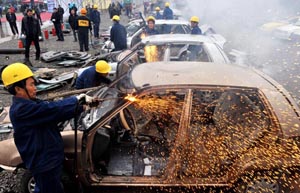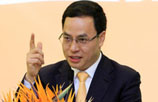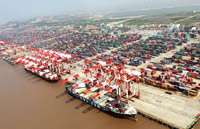Shares skid as selling pressure hits sentiment
By Li Xiang (China Daily) Updated: 2015-02-06 08:08What they say
|
 |
 |
 |
 |
 |
|
Chang Jian, chief China economist at Barclays Plc |
Jeremy Stevens, economist at Standard Bank |
Wang Tao, chief China economist at UBS AG |
Ding Shuang, senior China economist at Citigroup Inc |
Nathan Chow, economist with DBS Bank |
Chang Jian, chief China economist at Barclays Plc
The announcement came in slightly earlier than expected. The central bank was cautious in terms of permanently injecting liquidity using the RRR cut in 2014. We are now looking for a total of three RRR cuts in 2015. We maintain our forecasts of two interest rate cuts in the first and second quarters respectively.
Jeremy Stevens, economist at Standard Bank
Despite November's interest rate cut, monetary conditions are rather tight. Credit uptake has remained depressed as excess capacity and subdued demand are entrenched. We still expect the central bank to cut interest rates in the first quarter, and inject liquidity into the financial system.
Wang Tao, chief China economist at UBS AG
We see the RRR cut as mainly a liquidity management tool. One has to bear in mind that the RRR cut is merely off-setting the shrinking contributions from foreign exchange accumulation, and is not a large net liquidity injection that will amplify China's base money supply to result in massive credit expansion.
Ding Shuang, senior China economist at Citigroup Inc
The PBOC had been using short-term measures such as medium-term lending facilities and reverse repos to deal with a structural liquidity shortage. We have argued RRR cuts, by releasing long-term liquidity, are the more desirable response. RRR cuts can also reduce the funding cost of banks.
Nathan Chow, economist with DBS Bank
The relaxation can be seen as an effort to counter the impact of capital outflows. China's foreign exchange reserves also fell, suggesting renewed capital outflows amid concerns over the economy and the yuan. Against the backdrop of capital inflows reversing, at least one more RRR cut is expected this year.
- Decoding China's reserve requirement ratio
- Chinese stocks edge down after bank reserve requirement cut
- Chinese monetary policy likely to take wait-and-see mode: UBS
- China to focus on reforms, opening of capital market
- 2015 monetary policy, prudent with fine-tuning
- China to take paced monetary easing
- RRR cuts to ease liquidity conditions
- PBOC joins shift to boost growth
- Global firms that changed top execs after China biz hurdle
- Train-makers set for sales boost abroad
- Robust e-commerce boosts consumer sentiment in emerging markets
- Chinese firm launches village public welfare projects in Myanmar
- Decoding China's reserve requirement ratio
- Women-focused app to build relationships

















